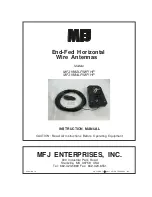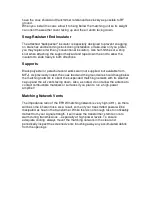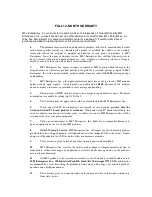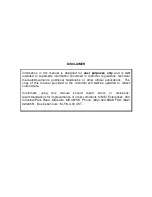
MFJ-1982LP/MP/HP and MFJ-1984LP/MP/HP
Instruction Manual
General Description
General Description:
End-Fed Horizontal Wire antennas (or EFHWs) cover
multiple bands without traps, stubs, or resonators. End-fed wires resonate on
their 1/2-wave fundamental frequency plus
all odd and even harmonics above
.
By adding a broad-band matching network, the wire's high impedance feed point
is transformed down to 50 ohms across a wide frequency range and, in most
cases, you won't need a tuner to operate. Note that the single-wire radiator may
be installed using only one high center or end support, making it fast and easy to
set up at home, on the road, or as a "grab-and-go" emergency antenna.
Models
Six versions of this antenna are available, allowing you to pick the one best
suited for your application.
[ ] MFJ-1982LP:
30-watts PEP, 80-10 meters
[ ] MFJ-1982MP:
300-watts PEP, 80-10 meters
[ ] MFJ-1982HP:
800-watts PEP, 80-10 meters
[ ] MFJ-1984LP:
30-watts PEP, 40-10 meters
[ ] MFJ-1984MP:
300-watts PEP, 40-10 meters
[ ] MFJ-1984HP:
800-watts PEP, 40-10 meters
All
MFJ-1982
models
come with 132 feet of antenna wire and cover 80, 40, 30,
20, 17, 15, 12, and 10 meters. The only difference between the LP, MP, and HP
version is the
power rating of the matching network
. The MFJ-1982 resonates
slightly above the 30-meter band, so a tuner is normally needed for transmitting.
Also, note that there is small 6-turn inductor wound into the antenna wire about
6-feet from the matching unit.
All
MFJ-1984
models
come with 66 feet of wire and cover 40, 30, 20,15, and 10
meters. Note that 17 and 12 Meters are not covered because they are not
harmonically related to the shorter wire length.
Power Rating
All ratings are in Watts-PEP using the SSB or CW mode and transmitting 50% of
the time or less per the ICAS (Intermittent Commercial and Amateur Standard).
These ratings do not apply to long key-down power applications where the
matching network could overheat. De-rate accordingly for these modes.


























